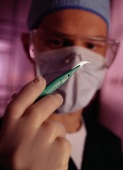- Navigating Your Midlife Crisis: Embracing New Possibilities
- City Raccoons Showing Signs of Domestication
- Mapping the Exposome: Science Broadens Focus to Environmental Disease Triggers
- One Week Less on Social Media Linked to Better Mental Health
- Your Brain Changes in Stages as You Age, Study Finds
- Some Suicide Victims Show No Typical Warning Signs, Study Finds
- ByHeart Formula Faces Lawsuits After Babies Sickened With Botulism
- Switch to Vegan Diet Could Cut Your Greenhouse Gas Emissions in Half
- Regular Bedtime Does Wonders for Blood Pressure
- Dining Alone Could Mean Worse Nutrition for Seniors
‘Doctor, Please Review This Checklist Before My Surgery’


Surgery might be less risky for patients if they have their surgical team follow a safety checklist, according to new research.
The study looked at the use of the World Health Organization’s surgical safety checklist, which was created in 2009 to reduce complications. It outlines 26 tasks that should be undertaken during the three phases of surgery: before anesthesia, before the incision is made and before the patient leaves the operating room.
Specific items on the checklist include reviewing a patient’s allergies before administering anesthesia, confirming the surgical site before cutting and making sure sponges and all other surgical instruments are accounted for before wheeling a patient out of the operating room.
Researchers gave the checklist to 43 patients who had their surgical team sign it to confirm they would follow it. Another group of 61 patients did not know about or receive the checklist.
Surgical teams were more likely to follow all 26 checklist items when operating on patients who had the checklists.
For example, allergies were confirmed in 95 percent of patients in the checklist group and 69 percent of patients without the checklist. The surgical site was confirmed before incision in 74 percent of checklist patients and 54 percent of those without a checklist. And formal counts of sponges and surgical instruments were done in 87 percent of checklist patients and 19 percent of those without a checklist.
All of the patients with a checklist said having it made them feel more comfortable before their surgery, according to the study, which is scheduled for presentation at a meeting of the American Society of Anesthesiologists being held in Dallas from Jan. 24 to 26.
“The checklist is only beneficial when it is used, and we found that involving patients helps ensure that surgical teams complied with it,” Dr. Seth Christian, director of quality for the department of anesthesiology at the Tulane University Hospital and Clinic in New Orleans, said in a society news release.
“Empowering patients to participate in their own care creates a culture of safety and makes them feel safer — and rightly so,” Christian said.
More information
Here’s where you can learn more about the WHO’s surgical safety checklist.
Source: HealthDay
Copyright © 2025 HealthDay. All rights reserved.










